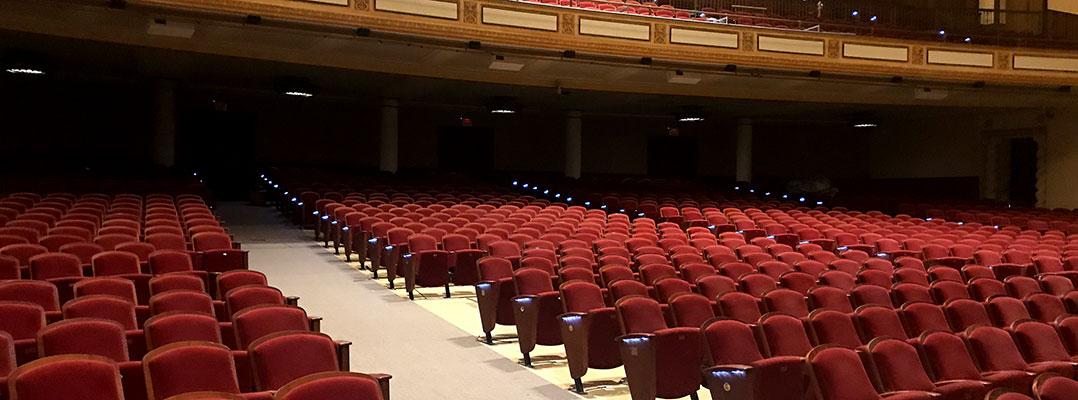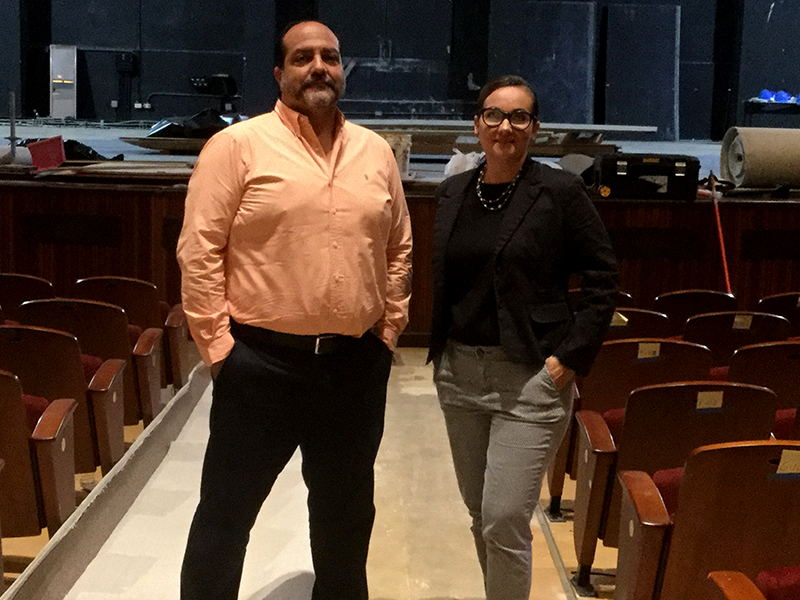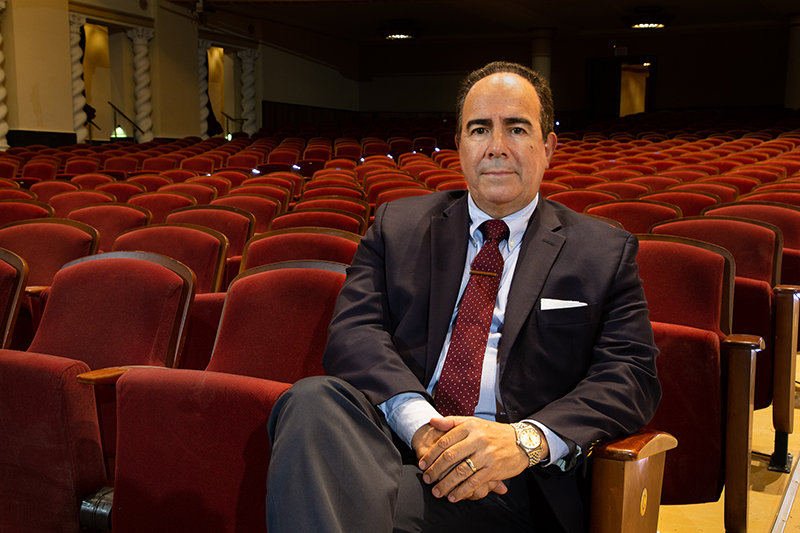
Exemplary Recovery of the IUPI Theater
By Mario Alegre-Barrios
Director of the Office of Communications, Development and Alumni
EXACTLY ONE year ago today, while all of Puerto Rico was under the brutal assault of one of the most devastating meteorological events in its history, our theater, the legendary Teatro of the University of Puerto Rico Río Piedras Campus—was also enduring damage so severe that it would have been impossible to imagine that, exactly twelve months later, its wounds would not have only healed, but also that it would be in the process of becoming the worthy host of a production of the scale of Hamilton, the celebrated musical that found great success on Broadway, and that will be shown here starting next January 8.
This hurried, and—by all means exemplary—rehabilitation of the emblematic structure that will celebrate its eightieth anniversary since its inauguration next year, has had as one of its fundamental financial ingredients the generous contribution of $1 million from Luis and Lin-Manuel Miranda, through the Flamboyan Foundation, as testimony of their commitment and trust in the IUPI as one of the crucial institutions in the development of Puerto Rico, most of all after the paradigmatic changes that hurricane Maria established as part of our new, thorny reality.
In a brief parenthesis of a loaded work schedule that knows not the meaning of time, architects Jennifer Lugo and Carlos Negrón-Roche—two of the people responsible for restoring life to the IUPI Theater, reflect on their impressions surrounding this project whose success is considered an example of what is possible when there is teamwork, talent, commitment and unity of purpose.
“Before Maria, the theater was in an acceptable enough condition to accomplish its mission, with some maintenance needs, just like any other building,” explains architect Lugo, who heads the project. “After Maria, the situation changed completely. When I arrived here on September 26 last year, the drop ceiling was detached in many places, and there were leaks everywhere, between the seats and on the stage. The windows in one of the dressing rooms had been blown away. The basement was flooded. Because of the flooding and the temperature, fungi spread. The entire area needed structural work. Since the roof gave out, everything else was at risk due to the vulnerable state the winds and rains had left it in. The seats had to be protected, and, fortunately, all of them were saved. They were the same seats installed in 2006. A working agreement was reached with the people from the Office of Conservation and University Facilities (OCIU, by its Spanish initials), the Office of Physical Planning and Development (OPDF, by its Spanish initials), and with a roof systems consultant. That’s how we were able to keep the theater protected while the former interim president of the university, Dr. Hillman, declared the project an emergency.”
Architect Lugo comments that “after the initial evaluation of the damage, our main objective was, at the very least, to restore the theater to the state it was in before Maria.”
“The reality is that, at that moment, we didn’t establish a specific time period for the physical intervention,” she says. “It was put on the list of buildings that needed urgent attention, not only because of its historical value and the gradual damage caused by the passage of time, but also due to its vital importance in the artistic and academic life on campus. We then started working on processes related to FEMA and insurance companies, while the University searched for a way to identify a budget to start the project before the insurance policy reimbursements arrived. We had very high expectations as to how much time would pass before recovery could be attained and we’ve continued working on that.
“During that phase,” architect Lugo claims, “there was a direct commitment from the campus’ interim chancellor, Dr. Luis Ferrao, to focus on the project, and Río Piedras came up with the certification for some funds to mitigate the damage to the roof.”

“The decision was made to complete the work in phases,” she mentions. “Presently, we have worked on phase 1, which focuses on the central chamber, process that will make interior work viable. There was a certification by the chancellor for $1,157,000, which incorporated all damages related to Maria, and those jobs that are essential–from a technical point of view—for Hamilton to be presented. To speed up the project, an emergency was declared, which is how the bidding processes were sped up. In this case, the contract was awarded to GVG Builders, and we have remained within the estimated budget, with a sum that reaches the amount, in construction alone, of $1,110,000.”
With the appearance of Hamilton on the horizon, plans to rehabilitate the theater were significantly transformed due to, among other things, the producers’ request to make digital technology available throughout most of the building, something that was previously limited.
“Additionally, the theatrical production has broad proportions, reason why we had to remove all stage equipment … the rigging system, the lights, the fire curtain, the speakers… and so on,” Lugo points out. “Regarding the dressing room area, minimum intervention is being done, with most of the remodeling focused on the changing room, next to the stage. Also, it has been decided to supply the theater with LED lighting, as well as replacing the ‘house lights’ system with something more modern. Because it is a historical building, we had to take a lot of care when deciding on how these improvements would be incorporated into the structure.»
“When it was decided that Hamilton would be brought to the theater, what were the main challenges you faced?”
“We’re talking about a historical theater that for many years was Puerto Rico’s main theater, the home of the Casals Festival,” says architect Negrón-Roche. “The best actors and actresses have come through here, the greatest thinkers. In 2006, the theater was reopened after a thorough restoration. Before Maria, it was, technologically speaking, in good condition. The greatest challenge was adjusting a production of Hamilton’s caliber, from the 21st century, from Broadway, which is technologically demanding, to a historical theater like ours, with characteristics that needed to be respected. We had to coordinate two teams—one in New York and one here—so that they could work together to protect Puerto Rico’s built patrimony, a building of 80 years that cannot be altered, mutilated or put at risk, and, at the same time, fulfill the technological demands of Hamilton.”
“Another major challenge was making the right decisions in order to comply with the short time available to get everything ready,” adds architect Lugo. “We couldn’t move the date because the commitments with Hamilton rigorously required that we abide by a specific deadline. There were no opportunities for experimenting. Everyone who has worked on this project has given us all of their support and commitment in an extraordinary way. The same can be said of university personnel, as well as the people representing Hamilton, to whom we would communicate a problem, only to have them come up with a solution a week later, always keeping present the fundamental importance of respecting the structure.”
“How far along is the project?”
“I would say 75%,” asserts Negrón-Roche. “This project has two aspects: mitigating the damage, and adapting to the technological requirements of the theatrical production. We are operating within the estimated time. The university reacted quickly when they recognized the urgency with which they needed to react. For the project’s success, it has also been very important to rely on the theater’s architect par excellence, José Coleman Davis, the inspection team from Adorno Arquitectos, as well as all theater personnel. Currently, we’re in a position to provide better offerings to local and international markets.”
“We can say that the Theater is the first building of the University that has been restored in an integral way after Maria,” says architect Lugo. “This is emblematic of what can be achieved when work is done in such a manner. The central chamber is ready, right on the first anniversary since the hurricane… The rest, what’s left, is in other parts of the structure. We are very satisfied with and proud of the result after all these months of work… And the people from Hamilton are also very happy with what has been achieved. We now have a world-class theater.”
On his part, the interim chancellor of the IUPI, Dr. Luis Ferrao Delgado, points out that “after its reopening with Hamilton next January, the repositioning of the theater as the heart of the academic and artistic activity in the university will have a new dimension.”
“The stage will be more attractive for world class productions, thanks, not just to the restoration, which has been generously supported by the Miranda family and the Flamboyan Foundation, but to the improvements this process has required,” affirms Dr. Ferrao-Delgado. “We hope that, during the Hamilton performances, we will be in a position to confirm, by title and date, the productions we will be holding during the next year. Among these productions will be concerts and another great musical. Without a doubt, this projects an image of our theater as a great bastion in our efforts to obtain external resources for the Campus, so necessary to finance our operations and continue our educational mission. I deeply thank the effort of everyone who has participated in this extraordinary project.”
